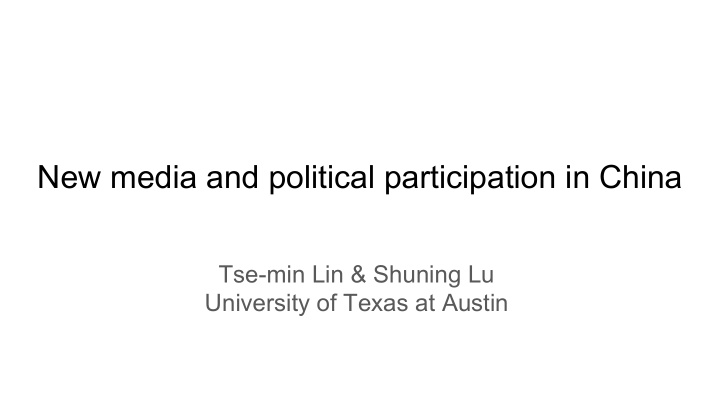



New media and political participation in China Tse-min Lin & Shuning Lu University of Texas at Austin
Normative debates Pro: large-scale information flow and decentralized mode of communication -> increased transparency, egalitarian communication Con: commercialization; state control; digital divides; social and political contexts + how people use it and what they use it for
Mixed result on new media and political participation New media effect on political participation in China Positive No/negative Collective action (Lei, 2011; Huang et al, 2017) Voting (Huang et al., 2017) Expressive engagement and civic group Petition, paying visits to membership (Zhou, 2015) government (Qi et al.,2013)
Gap in existing studies 1. Internet usage vs. internet penetration 2. Individual participation vs. aggregate participation - provincial 3. Participation modes: institutionalized vs. non-institutionalized 4. Cross-sectional data, lack of temporal dynamic
Statement of problem Do new media (as information ecology) affect political participation (different modes) in China’s provinces (at provincial level)?
Rational Choice Model of collective action Costly to produce public good Expressive benefits (speaking out -> efficacy, identity) ➔ ➔ Benefits go to everyone Selective - gain via participation ➔ ◆ Benefits (np) > Benefits (p) ++ by #. of participantes ➔ ◆ #. of participants -> critical mass ➔ Free-rider problem: reap w/o sowing Benefits (p)> Benefits (np) ➔
New Media Information Ecology Internet > Cell phone Type of information Volume Vast Low Social networks Open Close Communication capacity Mobility Low High Communication mode Mass Interpersonal Expressive benefits ++++ ➔ perceived likelihood of critical mass ++++ ➔ Media-system relationship Cost - - - ➔ Government control Tight Loose
New Media on Political Participation in China Petition (Letter, visits) Protest Government attitude Legally protected Illegal Scale Individual, small group Collective, large group Nature Individual grievance Social grievance Sociability/publicness Low (no ready audience) High (an audience) Consequence Maintain social order Disrupt social order Expressive benefits Limited and constant Potentially far-reaching Perceived likelihood of critical mass Social influence Contagion effect by new media Cost Partly reduce Ease coordination & mobilization
Methods : Data
Findings
Spatial diffusion of protests in China (2015)
Recap: New Media on Political Participation in China Petition (Letter, visits) Protest Government attitude Legally protected Illegal Scale Individual, small group Collective, large group Nature Individual grievance Social grievance Sociability/publicness Low (no ready audience) High (an audience) Consequence Maintain social order Disrupt social order Expressive benefits Limited and constant Potentially far-reaching [No effect, why?] Perceived likelihood of critical mass Social influence Contagion effect by new media Cost Partly reduce [Letter writing] Ease coordination & mobilization ➢ Repression tool A designated channel by gov ➢ New media ≠ enhancer ➢ ➢ spillover effect of online activism & expression
Discussion and future directions 1. Enrich and Refine the Data source Both provincial level and individual level data Longer time span of aggregate protest data 2. Multilevel Analysis Linking new media information ecology back to individual level action 3. Cross national comparison ABS data on China and Taiwan and beyond (will be released in early 2019)
Thank you! For further questions: tml@austin.utexas.edu shuninglu@utexas.edu
Recommend
More recommend